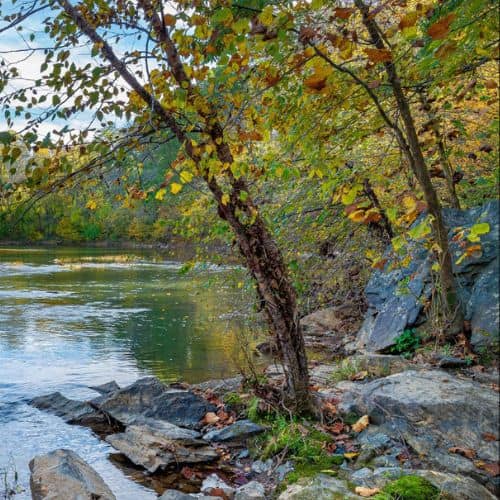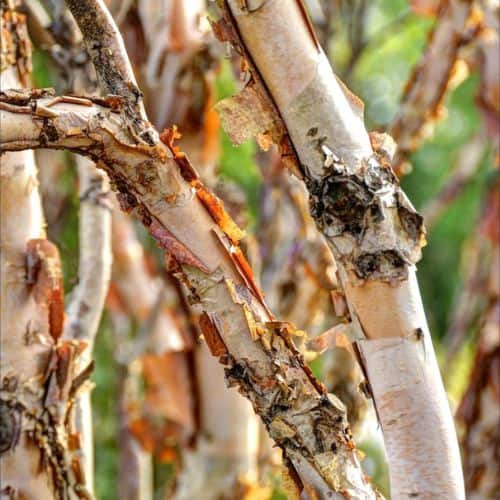The River Birch, scientifically known as Betula, is known for its distinctive peeling bark, airy foliage, and adaptability to diverse environments. Originating from the riverbanks and wetlands of North America, the River Birch thrives in environments with ample moisture. Its natural habitat has shaped the tree’s adaptability to various soil conditions, including well-drained and waterlogged soils.

Growing and Caring for River Birch
When planting a River Birch tree, choose a location with moist, well-drained soil. While these trees tolerate various soil types, they excel in soils with good drainage. River Birches are well-suited for both full sun and partial shade, offering flexibility in garden design. Adequate watering is crucial for optimal growth, especially during dry spells and the establishment phase. River Birches are well-suited for USDA hardiness zones 4 to 9.
Pruning is generally minimal for River Birches, as they naturally develop an open and graceful form. Removing dead or damaged branches, especially during the dormant season, contributes to the tree’s overall health. The peeling bark, a distinctive feature of River Birches, adds visual interest to the tree’s trunk and branches. This characteristic bark naturally sheds in thin, papery layers, revealing shades of cinnamon, salmon, and creamy white beneath. The unique bark becomes a captivating focal point in the winter landscape.
Size, Shape, and Growth Rate
River Birches typically reach heights of 40 to 70 feet (12 to 21 meters) at maturity. They boast an open and pyramidal to oval crown, creating an airy and graceful silhouette. The branches arch gently, and the foliage is distributed in a way that allows sunlight to filter through, creating dappled shade beneath the tree. Their size and shape make them suitable for various garden settings, including as specimen trees, along water features, or as part of mixed plantings.
The growth rate of River Birches is considered moderate, allowing for steady and reliable development. While they may not be rapid growers, their moderate pace contributes to their overall resilience and longevity. River Birches establish strong root systems, enhancing their ability to withstand environmental stressors. The moderate growth rate also ensures that the tree forms a well-balanced structure with branches that can withstand wind and weather gracefully. This reliability in growth makes River Birches valuable for landscaping projects where a consistent and well-proportioned tree is desired.
Leaves, Flowers, and Bark

The leaves of River Birches are simple, alternate, and serrated, showcasing a vibrant green color during the growing season. The foliage turns a bright yellow in the fall, contributing to the tree’s seasonal appeal. Inconspicuous flowers, known as catkins, appear in the spring before the leaves unfurl. The catkins are long and pendulous, adding a subtle charm to the tree. While the flowers may not be as showy as those of some other ornamental trees, they contribute to the overall grace and delicacy of the River Birch.
The real spectacle, however, lies in the bark, which undergoes a fascinating transformation as the tree matures. The bark peels away in thin, curling layers, revealing a spectrum of colors beneath — ranging from shades of cinnamon and salmon to creamy white. This unique characteristic lends the tree a year-round allure, creating a visual spectacle even in winter when the leaves have fallen. The peeling bark adds texture and interest to the tree’s trunk and branches and imparts a rustic charm to the landscape.
Uses in Gardening and Landscaping
River Birches create a picturesque scene, reflecting their natural habitat by flowing along water features such as ponds, streams, or low-lying areas. Their moderate size and graceful form suit urban landscapes, parks, and residential yards. River Birches are often used as shade trees, providing a dappled canopy that allows for the growth of understory plants. These trees can also be strategically placed to create year-round interest, especially when complemented by other plants that thrive in their shade.
In addition to their ornamental value, River Birches contribute to ecological balance. Their preference for moist soils makes them valuable in stabilizing streambanks and preventing soil erosion. The extensive root system of River Birches helps absorb excess water, reducing the risk of flooding in low-lying areas. The fallen leaves, which decompose and enrich the soil, contribute to the ecosystem’s overall health.
Our Selection of River Birch
At Martin Garden Center, we generally stock the Dura Heat River Birch as it is heat resistant and perfect for our Upstate climate. We try to have Dura Heat available year-round though we may fail depending on demand. We have carried the Little King dwarf River Birch which matures at around 10 feet tall. However, this cultivar is not commonly available.
